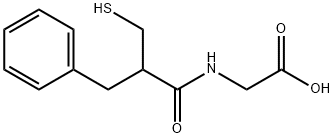Chemical Properties
Off-White Solid
Uses
Thiorphan is a potent inhibitor of neprilysin, a membrane metallo-endopeptidase that cleaves peptide hormones, such as enkephalins, glucagon, and bradykinin (Ki = 4-140 nM). It is much less effective against neprilysin-2 (IC50 = 22.1 μM), angiotensin-converting enzyme, and endothelin-converting enzyme-1. Thiorphan can be produced in vivo via the metabolism of the prodrug acetorphan. Neprilysin is overexpressed in many forms of cancer and may play a role in protecting against Alzheimer’s disease.
Uses
An Enkephalinase inhibitor
Uses
DL-Thiorphan has been used to evaluate the activity of NEP-dependent neutral endopeptidase. DL-Thiorphan has also been used for determining NEP enzymatic activity using fluorimetric assays.
Uses
The active metabolite
Definition
ChEBI: Thiorphan is a N-acyl-amino acid.
General Description
A thiol-containing amido-acid that selectively binds to the active site zinc of neprilysin (also known as neutral endopeptidase and NEP) and inhibits its activity (IC
50 = 2.1 nM). Inhibits the β-amyloid (Aβ) degrading activity of neprilysin
in vivo, but does not affect the secretion of either Aβ peptide or amyloid precursor protein (APP). Also shown to inhibit other neprilysin-related family members, such as mouse NL1 (IC
50 = 47 nM) and the neprilysin homolog from
Ascaris suum (IC
50 = 22 μM). Inhibits the activity of angiotensin-converting enzyme (ACE) (IC
50 = 140 nM), but has no effect on the activity of endothelin-converting enzyme (ECE).
Biochem/physiol Actions
Primary TargetNEP activity

